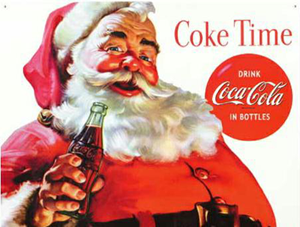Santa Claus: A Critical History
 Many theological rejections are quick to point out that Christmas has never been celebrated anywhere near the actual birthday of Jesus and widespread consumerism has overwhelmed any religious focus in the Western world. So I feel safe assuming that Christmas has little, if any, relationship to Christianity, though if it’s your Roman celebration of the Sun God, please carry on. (and send us photos!)
Many theological rejections are quick to point out that Christmas has never been celebrated anywhere near the actual birthday of Jesus and widespread consumerism has overwhelmed any religious focus in the Western world. So I feel safe assuming that Christmas has little, if any, relationship to Christianity, though if it’s your Roman celebration of the Sun God, please carry on. (and send us photos!)
So let’s look at popular culture in the U.S. and what’s actually going on with Christmas. Some capitalists go to great lengths to defend the consumerist tendencies of “the holidaze,” but we are going to take a step back in time and look at the origin story of Santa Claus.
Saint Nicholas was a Greek Bishop of the town Myra born in 280 AD. Myra was located in what is now Turkey, which must be where Nick got that dark-skinned complexion. It’s unclear when or why exactly he relocated to Germany and across Europe and finally to the North Pole, but we can safely conclude that this move was not approved by climate scientists and we also must express concerns about his importation of resources to such a remote location, particularly the raw materials used in his toy factories.
Slowly and surely his ethnicity was stomped out with age and his grey hair turned white. Nick was remembered as a fiery, wiry, and defiant defender of Christian doctrine while Rome was burning Bibles and executing Christians who wouldn’t renounce Christ. Nick was imprisoned until Constantine conquered the region and freed him. Nick didn’t get fat nor jolly until hundreds of years later but his gradual shift towards immortality after experiencing such life-changing events left him a little bonkers and with a changing metabolism.
Caroline Wilkinson, a facial anthropologist at the University of Manchester (England), used retrieved bones and modern software simulations to reconstruct his face. Apparently Nick had a badly broken nose, which National Geographic writer Brian Handwerk attributes to persecution of Christians under the Roman Emperor Diocletian.
 Eight hundred years later, as Nick had presumably retired to a remote location similarly to one of Tolkien’s Elves, he was remembered a bit like Yoda from his valiance in the wars against Rome. He was the patron saint of everyone from Sailors to children to entire countries to gift giving. In one tale he anonymously delivers three bags of gold to an indebted father to free his three daughters from lives of prostitution.
Eight hundred years later, as Nick had presumably retired to a remote location similarly to one of Tolkien’s Elves, he was remembered a bit like Yoda from his valiance in the wars against Rome. He was the patron saint of everyone from Sailors to children to entire countries to gift giving. In one tale he anonymously delivers three bags of gold to an indebted father to free his three daughters from lives of prostitution.
According to Gerry Bowler, author of Santa Claus: A Biography, Nick was opposed to pickling people as well. When he entered an inn back in the middle ages, he “sensed” that the owner had murdered three boys and was pickling their remains in the basement. He did the only respectable thing: he called the dude out and reincarnated the boys. Kids really took a liking to the guy after that.
Around the time of his Elven retirement, Nick took on a deeper mythology and started to anonymously deliver gifts across Europe. He also developed Norse superpowers like flight. Why he chose Europe instead of his homeland is likely related to imperialism and the changing color of his skin.
After the Protestant Reformation, parents thought Nick was pretty uncool because they associated him with religions that, like polka, weren’t so hip anymore. But kids were really digging on the guy, or at least on getting presents, so he got a Hollywood reboot and was now called Santa Claus instead. That made everyone happy.
 Nick’s mind continued to unravel and he became violent, now known as Ru-klaus (Rough Nicholas), Aschenklas (Ashy Nicholas), Pelznickel (Furry Nicholas), or even “The Horrific Christmas Devil” by various people in various countries at various times with an entirely new set of mythology. Children who did not cooperate with his edicts and demands for “good” behavior were whipped or even kidnapped.
Nick’s mind continued to unravel and he became violent, now known as Ru-klaus (Rough Nicholas), Aschenklas (Ashy Nicholas), Pelznickel (Furry Nicholas), or even “The Horrific Christmas Devil” by various people in various countries at various times with an entirely new set of mythology. Children who did not cooperate with his edicts and demands for “good” behavior were whipped or even kidnapped.
It was somewhere around this time that he needed more than powers of flight and set up his elaborate toy factories somewhere in the North Pole. Lacking a fitting labor force, he imprisoned a colony of Elves who were half of the size of their more common Woodland or Underdark brethrens and ran the factories under their operation. Shortly thereafter, he was able to expand his operation virtually worldwide. But were all of these compromises worth it?
Nonetheless, children in The Netherlands continued to believe in Nick and as they emigrated to The Americas, they defended his good name and spread the stories of how to get sweet gifts on December 25. But in New England the holiday was rejected and celebrated in private due to being associated with the Pagan “Saturnalia,” an outdoor alcohol-fueled blowout, simply because it was celebrated on the same day.
It wasn’t until 1809 that yet another Holiday reboot occurred to put Santa back into a positive light. Poets and writers created a new mythology—that Christmas was a family holiday celebration. It was around this time that Santa also began dressing in Germanic furs and became interested in animal enslavement to ensure that he could maintain the rigid schedule of planet-wide distribution. Santa started packing a birch rod that he instructed parents to strike their children with when they strayed from “virtue’s path.” It might have been about time for Santa to consider “virtue’s path” himself. This series of inhumane behavior may explain how and why Santa was stripped of any religious association in 1821 in the anonymous poem “The Children’s Friend.”

Over the next one hundred years Santa gained and lost thousands of pounds and entered into marketing and product representation contracts with the Coca Cola corporation, drawing massive protest from the anti-capitalist movement. Rumors indicate that Santa used the funds from Coca-Cola to expand the size of his factories and production footprint. He also hired an elaborate PR firm to tell Europe about his new image. The transformation worked and they forgot his violent and conflicted past, buying into the American version of Santa, as a rolly-polly and jolly white guy with white beard, rosy cheeks and white trim on his suit. It was one of imperialism’s greatest moments, though they told him that he couldn’t wear the indecent long johns anymore. Local customs gave him their own names in translation, like a Disney movie. For example, he was Père Noël in France, Sinterklaas in Holland, and Father Christmas in Great Britain.
But in Russia, Grandfather Frost (Santa) crossed the great Josef Stalin and when the Soviet Union was formed, the idea of Christmas gift-bringing was dumped on the curb. By the 1930s Stalin needed to fix his public opinion and tried to build a new alliance with Frost, allowing him to deliver gifts again on New Years. Communist Santa tried to cooperate, wearing a blue coat and expressing secular values, catching on in Poland and Bulgaria but the image ultimately flopped and people recognized that jolly white guy for who he was when the Soviet Union collapsed in 1989.
 In contemporary times, Santa is sometimes seen to represent commercialization due to his full-on adoption of capitalist values and enslavement production models. The Ghost of Ayn Rand gave him a three star review in her post-humous book, The Tyranny of Not Being Selfish, proclaiming “Santa Claus Is the only honest representation of capitalist enterprise in a world gone mad even if he has a way to go on selfishness,” and “Santa found the last outpost of free enterprise on Earth but is not exploiting it to its full potential.” For reasons like these, the Czech Republic, the Netherlands, Austria, Portland, OR, the TV show Seinfeld, and Latin America all maintain critical views on Santa Claus, opting instead for local customs.
In contemporary times, Santa is sometimes seen to represent commercialization due to his full-on adoption of capitalist values and enslavement production models. The Ghost of Ayn Rand gave him a three star review in her post-humous book, The Tyranny of Not Being Selfish, proclaiming “Santa Claus Is the only honest representation of capitalist enterprise in a world gone mad even if he has a way to go on selfishness,” and “Santa found the last outpost of free enterprise on Earth but is not exploiting it to its full potential.” For reasons like these, the Czech Republic, the Netherlands, Austria, Portland, OR, the TV show Seinfeld, and Latin America all maintain critical views on Santa Claus, opting instead for local customs.
An inspiration of both charity and greed, Nick was not anti-war like his Jesus and reported to generals during 3rd century wartime. Perhaps they liked his kick ass miracles. In any event, it’s important to remember a person for the entire scope of their legacy, warts and all.